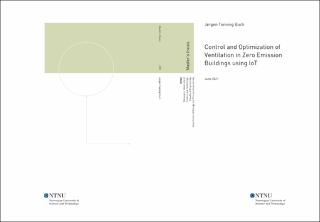| dc.contributor.advisor | Mathisen, Hans Martin | |
| dc.contributor.advisor | Alonso, Maria Justo | |
| dc.contributor.author | Buch, Jørgen Tonning | |
| dc.date.accessioned | 2021-09-30T16:19:17Z | |
| dc.date.available | 2021-09-30T16:19:17Z | |
| dc.date.issued | 2021 | |
| dc.identifier | no.ntnu:inspera:80323884:17912654 | |
| dc.identifier.uri | https://hdl.handle.net/11250/2786739 | |
| dc.description.abstract | En stor del av det totale energiforbruket i bygg kan knyttes til ventilasjon og bygningsklimatisering. Behovsstyr ventilasjon (DCV) kan benyttes som et tiltak for å senke det totale energiforbruket. Som et ledd i utviklingen av DCV har lav-kostnads sensorer som måler ulike inneklimaparametere blitt ett fokusområde. Både med tanke på muligheter til å måle inneklima sammenliknet med anerkjente sensorer, og hvorvidt de kan benyttes til å styre DCV. Denne oppgaven ser videre på muligheten til å benytte lav-kostnads sensorer til å kontrollerer ventilasjon på bakgrunn av forskjellige inneklimaparametere.
For å tilrettelegge for videre testing av DCV strategier, ble et provisorisk kontorområde planlagt og påbegynt bygget i laboratoriet. Dette innebar prosjektering av et DCV anlegg samt selve byggingen av kontorområdet. Det planlagte kontorområdet i laboratoriet satte rammeverket for simuleringer som er gjennomført i CONTAM. CONTAM ble brukt til å undersøke innvirkningen til DCV på luftkvalitet og energiforbruk. Denne oppgaven tar for seg forskjellige kontrollstrategier for DCV basert på målinger av CO2 og HCHO. Total ble fem DCV strategier analysert og sammenliknet gjennom simuleringer. I tillegg ble tre kontrollstrategier for styring av omluft undersøkt. De kontrollstrategiene for omluft er basert på målinger av CO2, en kombinert løsning med måling av CO2 og HCHO, og målinger av PM2.5.
Implementering av omluft viste seg å være vanskelig uten å forstyrre kontrollen av tilluft. Siden reguleringen av omluft og tilluft er styrt av samme parametere, konkurrerer dem om autoritet. Dermed ble reguleringen ukontrollerbar. Med de forutsetninger som er satt i denne oppgaven, kan ikke omluftstyring anbefales som et ledd i å senke energiforbruket eller øke luftkvalitet.
Simuleringene viser at DCV kontrollert av CO2 holder nivået av HCHO under anbefalte grenseverdier i arbeidstiden. Men, om emisjonsraten er for høy, kan HCHO akkumuleres og stige over anbefalte grenseverdier utenfor arbeidstid. Simuleringene viser at ventilasjon styrt av CO2 og HCHO hindrer akkumuleringen av HCHO og sikrer bedre inneklima. Estimering av energiforbruk tilknyttet oppvarming og viftedrift viser stort potensiale til å spare energi sammenliknet med CAV. DCV styrt av CO2 og HCHO sparer opp mot 31 % av energiforbruket sammenliknet med CAV for den simulerte uken. Basert på disse resultatene anbefales DCV styrt av CO2 og HCHO for videre undersøkelser i laboratoriet. | |
| dc.description.abstract | Ventilation accounts for a large amount of energy use in buildings. A large amount of a building's total energy consumption is related to heating, cooling, and ventilation. DCV can be used as means to achieve more energy-efficient buildings. In context with the progress surrounding DCV, low-cost IAQ sensors are a subject of investigation. Low-cost sensors have shown improvement in the sensor's performance compared to recognized IAQ sensors and their relevance in controlling ventilation. This thesis further explores the possibilities of using low-cost IAQ sensors to control a DCV system based on IAQ measurements.
To facilitate the investigation of DCV control strategies, a provisional office area supplied with a DCV system was planned. The planned office area determined the framework for simulations. The simulation program CONTAM was used to compare the impact on IAQ and energy consumption for different DCV control strategies. Indoor air concentration of CO2 or HCHO or a combination of CO2 and HCHO was the basis for the proposed DCV control cases. Five control cases were investigated and compared. In addition to supply air control, the CONTAM simulations contain an investigation of three control algorithms for recirculation of extract air. Indoor air concentration of HCHO, indoor air concentration of HCHO and CO2, and indoor air concentration of particulate matter are the basis of the three recirculation controls.
Combining the DCV control strategies with the recirculation controls investigated in this thesis did not show promising results. The intent of implementing recirculation control was to lower the overall energy use. Simulations show that implementing recirculation control based on the same parameters as the supply airflow control did not work. The recirculation controls ended up being unstable and contradictory in terms of saving energy and achieving better IAQ.
The simulations in CONTAM show that ventilation controlled by the indoor concentration of CO2 can keep HCHO below the recommended indoor threshold limit during working hours. But, pending on the base ventilation rate and pollutant generation rate, the level of HCHO exceeds the threshold limit outside working hours. The CONTAM simulation shows that a combined HCHO and CO2 DCV control strategy prevents accumulation of HCHO and achieves better IAQ. Compared to CAV, the DCV controls investigated will save energy related to heating and operation of fans. The DCV control based on CO2 and HCHO saved a total of 31 \% energy compared to CAV for the simulated week. Based on these results, the combined CO2 and HCHO control is recommended for further investigation in the laboratory. | |
| dc.language | eng | |
| dc.publisher | NTNU | |
| dc.title | Control and Optimization of Ventilation in Zero Emission Buildings using IoT | |
| dc.type | Master thesis | |
